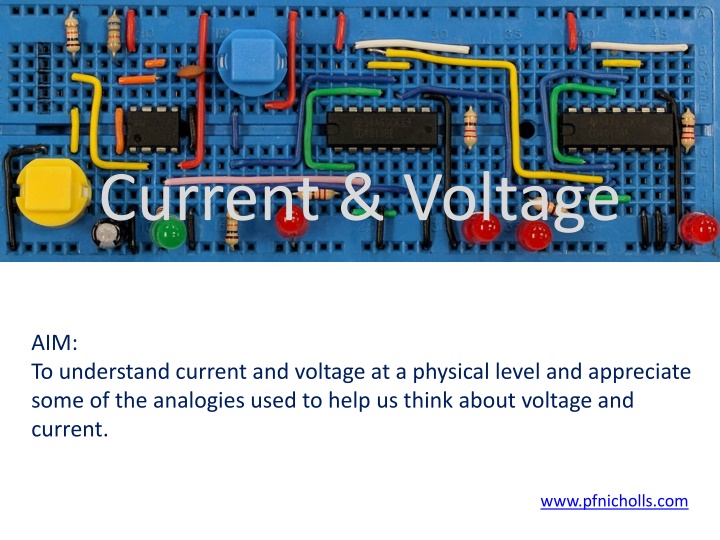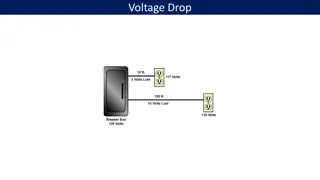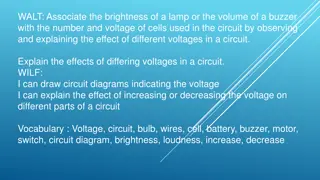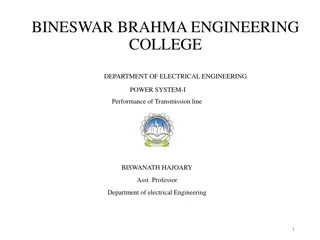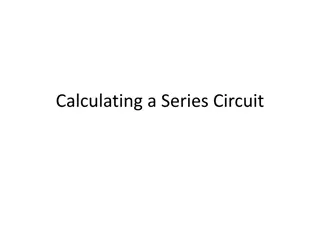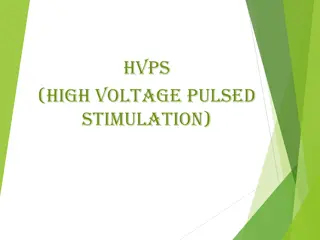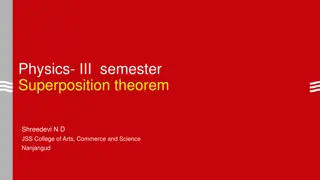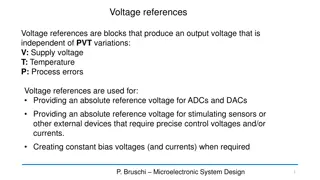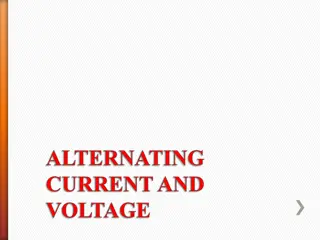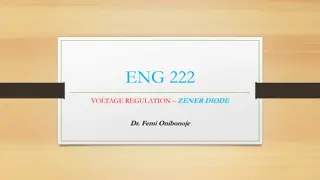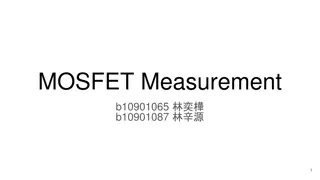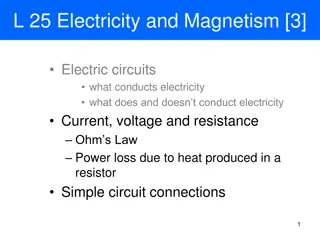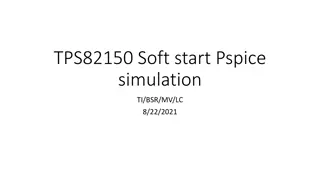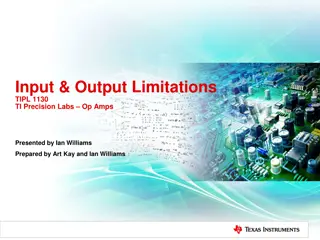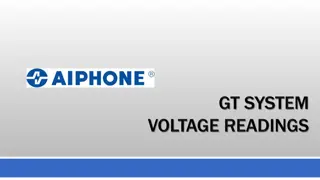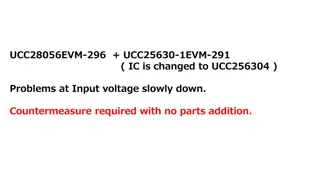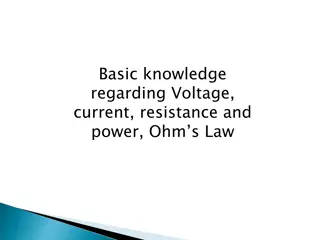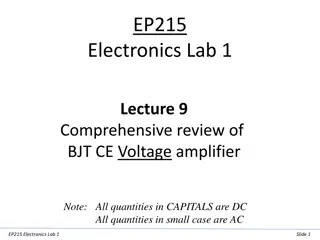Current & Voltage
Delve into the concepts of current and voltage in electrical circuits, exploring their definitions, measurements, and behaviors. Learn about charge flow, unit conversions, example calculations, and the rules governing current in series and parallel circuits. Discover analogies that aid in visualizing these fundamental principles.
Download Presentation

Please find below an Image/Link to download the presentation.
The content on the website is provided AS IS for your information and personal use only. It may not be sold, licensed, or shared on other websites without obtaining consent from the author.If you encounter any issues during the download, it is possible that the publisher has removed the file from their server.
You are allowed to download the files provided on this website for personal or commercial use, subject to the condition that they are used lawfully. All files are the property of their respective owners.
The content on the website is provided AS IS for your information and personal use only. It may not be sold, licensed, or shared on other websites without obtaining consent from the author.
E N D
Presentation Transcript
Current & Voltage AIM: To understand current and voltage at a physical level and appreciate some of the analogies used to help us think about voltage and current. www.pfnicholls.com
Overview In this presentation we aim to try and understand current and voltage at a Physical level and get a feel for what is actually going on in an electrical circuit. There are three sections: The (mathematical) definition of current with several examples and a consideration of how current behaves in a circuit The (mathematical) definition of voltage with several numerical examples and a consideration of how voltage behaves in a circuit Four analogies to help visualise current and voltage: Water in pipes analogy Water flowing up and down a hill analogy Coal trucks driving along a road analogy Students walking around a classroom analogy Learn these equations they will be useful
Current Current is to do with the rate of flow of charge. This means current tells us how much charge is passing any point in the circuit each second. Current = total charge that has passed a point time taken I = Q / t or Q = I t I = current measured in amperes (A) or Amps Q = charge past a point in the circuit measured in coulombs (C) t = time taken measured in seconds (s) Therefore: 1 Amp = 1 coulomb per second
Current Current is measured in Amps using an ammeter. In electronics 1 Amp is quite a large current and so smaller units are commonly used: 1 milliamp = 1mA = 1/1000 Amp = 0.001A = 1x10-3A 1 microamp = 1 A = 1/1000000 A = 0.000001A = 1x10-6A In power stations and industry, much larger units are used: 1 kiloamp = 1kA = 1000A = 1x103A 1 Mega amp = 1MA = 1000000A = 1x106A
Current Example Calculations 1. A current of 5 Amps flows for 2 seconds. How much charge has passed around the circuit? Q = I x t Q = 5 x 2 = 10C 2. How long does a current of 4mA need to flow for to move 3C of charge round the circuit? t = Q I t = 3 / (4x10-3) = 750s 3. In an experiment, 6C of charge flows in 10 minutes. What is the average current? I = Q t I = 6 / (10 x 60) = 0.01A = 10mA 4. In a lightning strike transfers 700C of charge in 2ms. What current flows? I = Q t I = 700 / (2 x 10-3) = 350kA
Current in Series & Parallel Charge is conserved you can t lose or gain charge as it moves around a circuit. This gives us the current laws: Current in a SERIES circuit is the same at all points in the circuit. Current in a PARALLEL circuit splits at a junction. The currents in each branch all add up to give the total current before the junction. In both cases, the charge flowing in to the component or junction each second must equal the charge flowing out otherwise there would be a build up of charge somewhere
Voltage Voltage is to do with the energy carried around the circuit by the charge carriers. The amount of energy carried by an individual charge carrier is very small so we consider the energy transferred by a whole unit of charge the Coulomb. Voltage = Energy transferred per Coulomb of charge V = W / Q or W = V x Q V = Voltage measured in volts (V) W = Energy transferred or Work done measured in joules (J) Q = Charge measured in coulombs (C) 1 V = 1 J / C
E.M.F & Potential Difference Voltage is about energy being transferred from one form to another. There are two possible cases where this happens in an electrical circuit. When energy is transferred from some other form into electrical energy, we call this voltage an E.M.F (Electromotive force). Cells, generators and solar panels have an E.M.F as they produce electrical energy from some other form of energy (chemical etc) When energy is transferred from electrical energy to some other form we call this a potential difference (P.d). Bulbs, heaters, loudspeakers have a potential difference across them as they use electrical energy a heater transfers electrical energy to thermal
Voltage Voltage is measured in volts. In electronics, a volt is a very common reasonable value e.g. a battery produces a few volts. Other units are also used. In audio systems we find mV, in our nervous systems we have V , power stations use kV and Physics research enjoys MV. 1 millivolt = 1mV = 1/1000 volt = 0.001V = 1x10-3 V 1 microvolt = 1 V = 1/1000000 V = 0.000001V = 1x10-6 V 1 kilovolt = 1kV = 1,000V = 1x103 V 1 Megavolt = 1MV = 1,000,000V = 1x106 V
Voltage Example Calculations 1. A 12V battery transfers 100J of energy. How many coulombs of charge must flow through the battery? Q = W V Q = 100 / 12 = 8.33C of charge 2. 20C of charge pass through a 1.5V cell. How much energy is transferred to the circuit? W = V x Q Energy transferred = 1.5 x 20 = 30J 3. A mains bulbs transfers 920J of energy when 4C of charge pass through it. What is the mains voltage? V = W Q V = 920 / 4 = 230V
Voltage in Series & Parallel Energy is conserved. The energy total transferred in to electrical energy (E.M.F) must equal the total energy transferred from electrical energy (P.d) in any given complete path around a circuit. This gives us the voltage laws Voltages in a SERIES circuit all add up. The total EMF in the circuit equals the total P.d. across all the components The voltages across all the bulbs adds up to the voltage across the cells. Note that the voltage across each bulb does not have to be the same it doesn t have to divide equally
Voltage in Series & Parallel In a parallel circuit, whichever path charge carriers go down, they must transfer the same amount of energy. Therefore, in a parallel circuit, the voltages are all the same. Voltages across two components in PARALLEL are always the same. The P.d. across each bulb must be the same (but the current through each can be different)
Circuit Analogies Water flowing through Pipes to make a water circuit E.g. The water circuit in a central heating system Analogies: Analogy: Water being pumped round a network of pipes is like electrical current flowing around an circuit. A pump increases the water pressure in the pipes and causes the water to move. Radiators and valves prevent the water from flowing. Good For: Understanding current flow in series and parallel circuits Water Flow of water Pump Pressure difference Radiators Valves Pipes Wires Flow-meter Pressure gauge charge carriers Current Battery P.d. Resistance Switches Ammeter Voltmeter
Circuit Analogies The water flowing around the circuit is analogous to current in an electrical circuit. It divides at a junction and then comes back together neatly illustrating how electrical current behaves at a junction. The water current is measured in litres per second just as the electrical current is measured in Coulombs per second.
Circuit Analogies Water pumped up high and then flowing back down hill E.g. The water ride at an amusement park Analogy: Water is pumped up to a height gaining potential energy which is analogous to charge carriers going through a cell gaining electrical energy. The height represents the voltage . Water flowing downhill gains kinetic energy but loses height. Water flowing along a level channel loses no height just as current through a wire does not require a (significant) Pot. Diff. Good For: Understanding voltage and potential difference in series and parallel. Analogies: Flow of water Pump Height/Pot. Energy Change of height Current Battery Voltage Pot. Diff.
Circuit Analogies Voltage is analogous to the height. This analogy shows how voltages relate to each other. Which ever route the water takes, the gain in height is equal to the loss of height around a complete circuit loop. h1 = h2 (Emf = Potential Difference) h1 = h3 + h4 (Voltages in series add up)
Circuit Analogies Coal trucks driving along roads between a coal mine and several factories dropping off coal along the way Analogy: A Coal mine provides coal. This is transported by road to different factories etc. Each factory uses some of the coal and the trucks return to the mine empty ready to be filled up and start a new circuit. The number of trucks passing a point each second can be counted and the amount of coal in each truck measured. Good For: Understanding potential and current, nature of charge carriers Analogies: Trucks Coal Flow of trucks Road Coal Mine Factories Charge carriers Energy / Potential Current Wires Battery Resistors
Circuit Analogies Students walking around a pretend circuit in a classroom Analogy: Students are only allowed to walk along a set route. One student is the cell and gives out sweets. Other students are bulbs and collect sweets. The remaining students carry the sweets from one part of the room to another but do not get to keep the sweets. There may be more than one route for a parallel circuit. Good For: Understanding voltage and current and why cells go flat Analogies: Route Moving students Sweet provider Sweets Sweet collector Wires Current Battery Potential / Voltage Bulb
Summary Current is the flow of charge Q = I x t Voltage is the energy transferred by moving charges V = W / Q The current is the same at all points in a series circuit The current at a junction in a parallel circuit adds up what goes in must come out The potential differences around a series circuit add up to the EMF of the circuit The potential difference is the same across parallel components Analogies help understand current and voltage
Questions 1. What charge is transferred when a current of 3A flows for 10s ? 2. What charge is transferred by a current of 100mA in 2 minutes? 3. A lightning strike transfers 30C of charge in 4ms. What is the average current flowing? 4. How long does it take to transfer 100C of charge when a current of 400 C is flowing around the circuit? 5. How much energy is transferred by a 12Vbattery when 4C of charge flows through the battery? 6. A 12V battery can provide 20A for an hour before becoming flat. How much energy does the battery store when fully charged?
Answers 1. Q = I x t Q = 3 x 10 = 30C = 30 coulombs of charge Q = 100 x 10-3 x (2 x 60) = 0.1 x 120 = 12C 2. Q = I x t I = 30 / (4 x 10-3) = 30 / 0.004 = 7500A = 7.5kA 3. I = Q / t t = 100 / (400 x 10-6) = 250,000s 2.9 days 4. t = Q / I 5. W = V x Q W = 12 x 4 = 48J 6. W = V x Q and Q = I x t Q = 20 x (1 x 60 x 60) = 72,000C W = 12 x 72,000 = 864,000J
